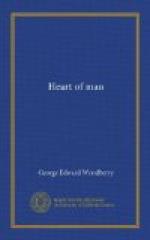The Roman domination in its turn slowly moved to its fall; and where should the new age begin more fitly than in this city of beginnings? As of old the Greek torch first gleamed here, here first on Sicilian soil was the Cross planted. The gods of Olympus had many temples about the hill slopes, shrines of venerable antiquity even in those days; but if the monkish chronicles be credited, the new faith signalized its victory rather over three strange idolatries,—the worship of Falcone, of Lissone, and of Scamandro, a goddess. I refuse to believe that the citizens were accustomed to sacrifice three youths annually to Falcone; and as for the other two deities, little is known of them except that their destruction marked the advent of the young religion. Pancrazio was the name of him who was destined to be our patron saint through the coming centuries. He was born in Antioch, and when a child of three years, going with his father into Judea, he had seen the living Christ; now, grown into manhood, he was sent by St. Peter to spread the gospel in the isles of the sea. He disembarked on our beach, and forthwith threw Lissone’s image into the waves, and with it a holy dragon which was coiled about it like a garment and was fed with sacrifices; and he shattered with his cross the great idol Scamandro: and so Taormina became Christian, welcomed St. Peter on his way to Rome, and entered on the long new age. It was here, as elsewhere, the age of martyrs—Pancrazio first, and after him Geminiano, guided hither with his mother by an angel; and then San Nicone, who suffered with his one hundred and ninety-nine brother monks, and Sepero and Corneliano with their sixty; the age of monks—Luca, who fled from his bridal to live on Etna, with fasts, visions, and prophecies; and, later, simple-minded Daniele, the follower of St. Elia, of whom there is more to be recorded; the age of bishops, heard in Roman councils and the palace of Byzantium, of whom two only are of singular interest—Zaccaria, who was deprived, evidently the ablest in mind and policy of all the succession, once a great figure in the disputes of East and West; and Procopio, whom the Saracens slew, for the Crescent now followed the Cross.




